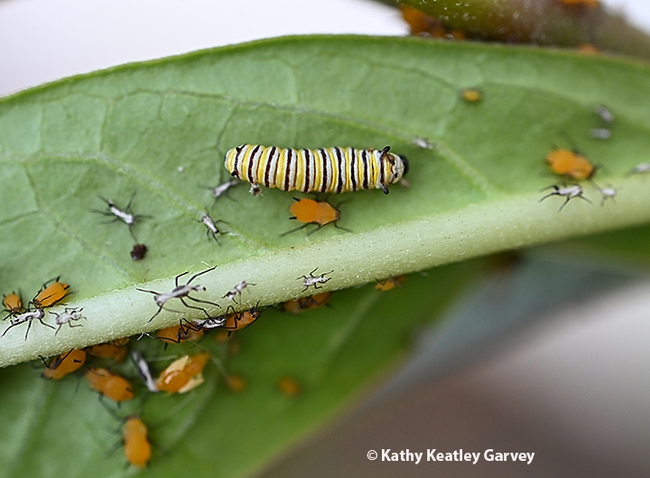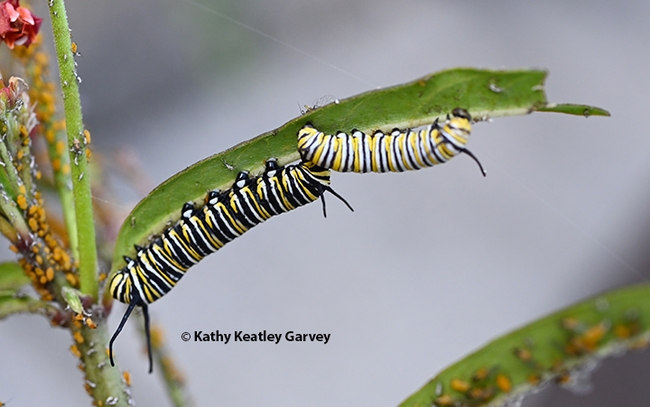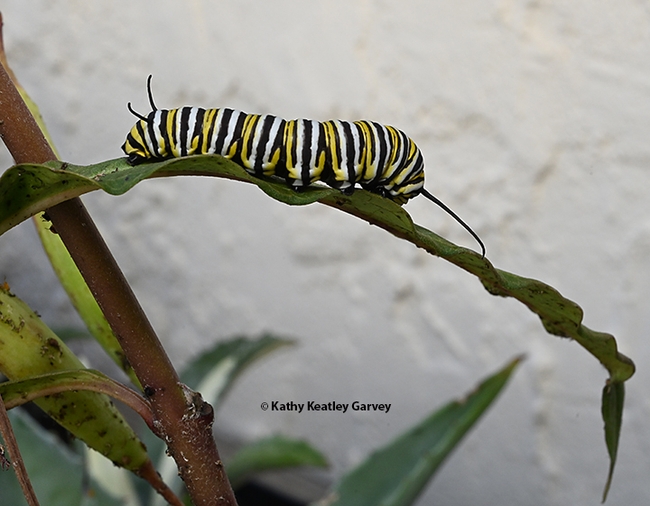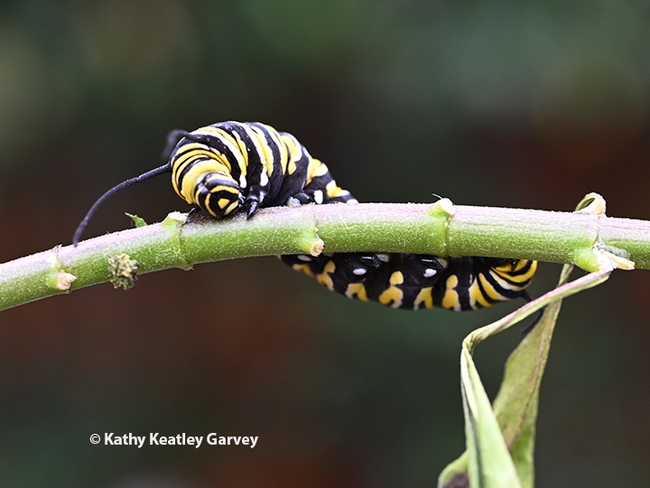- Author: Kathy Keatley Garvey
On Sept. 6, 2016, it happened.
A monarch fluttered into our pollinator garden in Vacaville and touched down on a Mexican sunflower, Tithonia rotundifola.
It wasn't just "any ol' monarch"--if there's ever such a thing as "any ol' monarch."
This one, tagged with my alma mater, Washington State University, came from Ashland, Ore., as part of a migratory monarch research project launched by entomologist David James.
The tag's serial number read “Monarch@wsu.edu A6093.” It hung around for about five hours and then left.
James, an associate professor at Washington State University, studies the migration routes and overwintering sites of the Pacific Northwest Monarch population, which overwinter primarily in coastal California. (Access his Facebook page, Monarch Butterflies in the Pacific Northwest, for his latest research.)
When we emailed him, we learned that citizen scientist Steven Johnson of Ashland tagged and released the monarch on Sunday, Aug. 28.
"So, assuming it didn't travel much on the day you saw it, it flew 285 miles in 7 days or about 40.7 miles per day," James told us. "Pretty amazing. So, I doubt he broke his journey for much more than the five hours you watched him--he could be 100 miles further south by now."
Repeat: 285 miles in 7 days, or 40.7 miles per day. Incredible.
Fast forward to today. It's the anniversary of the sighting of A6093.
Any sightings today? Not. A. Single. One.
And not a single sighting of a tagged monarch since Sept. 6, 2016.
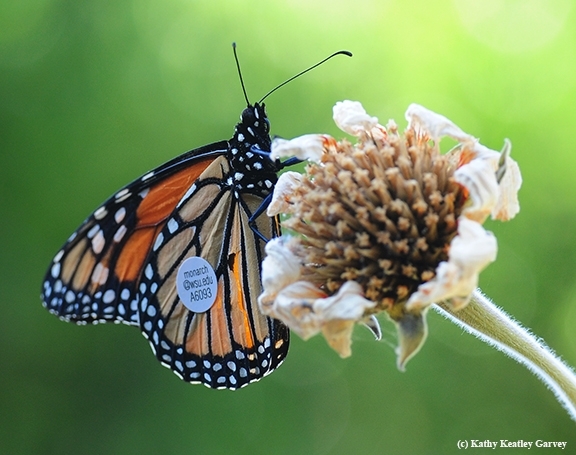
- Author: Kathy Keatley Garvey
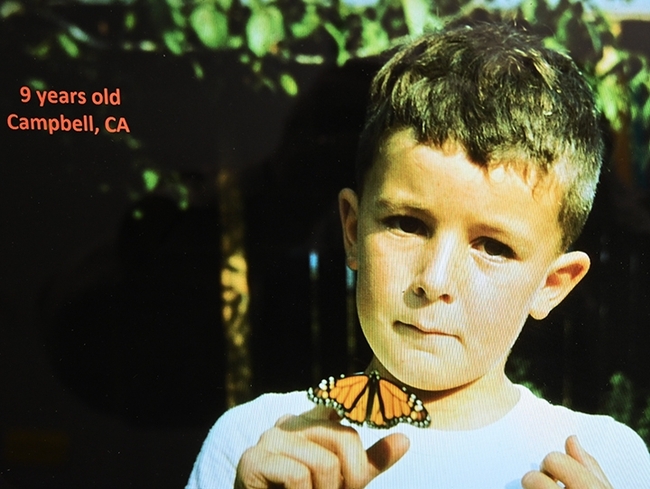
Scientists estimate that only 10 percent of the eggs and 'cats survive to adulthood.
They don't "survive" at all in California classrooms.
California classrooms used to showcase the metamorphosis of the monarch--from egg to caterpillar to chrysalis to adult-- but no more. If you live in California, you're not allowed to collect or rear monarchs without a scientific permit. And scientific permits are difficult to obtain.
According to the California Department of Fish and Wildlife: "A Scientific Collecting Permit (SCP) is required to handle wild monarchs in California including for educational purposes. It is unlawful to collect, remove from the wild and/or captively rear monarchs in California without an SCP, per California Code of Regulations (CCR), Title 14, section 650.
Admire them in the wild, but legally, you can't collect or rear them.
As a child growing up in the San Jose area, entomologist Jeff Smith, curator of the Lepidoptera collection at the Bohart Museum of Entomology, UC Davis, "raised and released many, many dozens of monarchs, as most empty lots were filled with vast stands of narrow-leaf milkweed, and we could easily gather caterpillars and keep them fed and healthy until they matured. This was an extraordinary thing to be able to watch--the final instar of the larva molting to change to the beautiful chrysalis and then seeing the butterfly develop within the chrysalis and hatch. We would hold it on our finger as the wings expanded and, finally, the butterfly flew away."
The Bohart Museum has some seven drawers of monarch specimens. "With around 60 specimens per drawer that could amount to nearly 400 plus specimens (some drawers are not full," he said. The collection also includes nearly-white monarch specimens from Hawaii.
In their book, The Lives of Butterflies: A Natural History of Our Planet's Butterfly Life (Princeton University Press, 2024), authors David James and David Lohman point out that "...our children are the future and it is they who will determine the future of butterflies. If a child finds a caterpillar, let them keep it, feed it, and watch it metamorphose.They will remember the experience for the rest of their life, and it will instill in them a love and appreciation for lives smaller than their own."
James is an entomologist and associate professor at Washington State University who researches migratory monarchs, and Lohman is a biologist, professor and department chair, City College of New York.
“It is important that we do not try to excessively regulate to conserve butterfly populations," they wrote. "We need people to be part of the process and be the power on the ground behind conservation programs.”
They quote Lincoln Brower (1931-2018), a renowned Lepidopterist educated at Princeton and Yale universities: “Butterflies are treasures, like great works of art. Should we not value them as much as the beauty of Picasso's art or the music of Mozart or the Beatles?"
Robert Michael Pyle, founder of the Xerces Society for Invertebrate Conservation, and colleague David L. Wagner, advocated "Keep Nets in the Hands of Kids--and Others" in a piece in the fall edition of the Lepidopterists' Society newsletter. They asked:
"Is the coup de grace for children's face-to-face fascination with small-scale life to be delivered now by well-intentioned but ill-considered regulation?"
Smith declared that the regulation will not "help" with the conservation of monarchs, and that he hopes it will be reversed or modified.
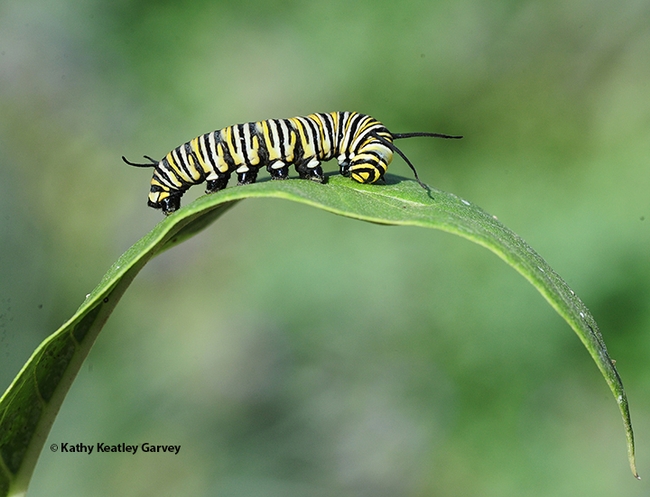
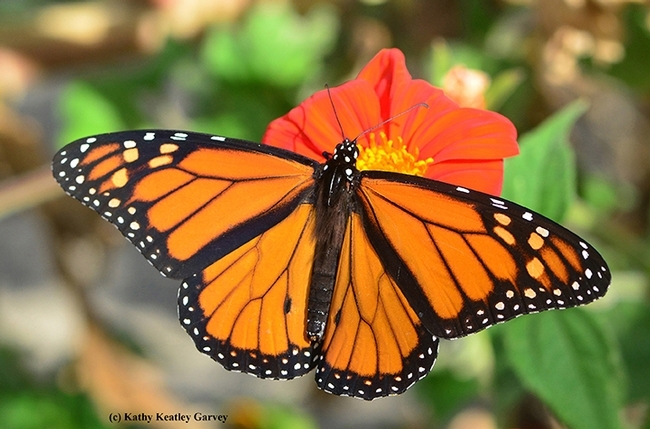
- Author: Kathy Keatley Garvey

The Brower quote appears in a newly published book authored by two renowned scientists who research butterflies. The book, an introduction to butterflies of the world, is a “must-have” on your bookshelf.
The book: The Lives of Butterflies: A Natural History of Our Planet's Butterfly Life
The authors: Entomologist David James, associate professor, Washington State University and biologist David Lohman, professor and department chair, the City College of New York.
The publisher: Princeton University Press
Publication date: (U.S.) Jan. 9, 2024.
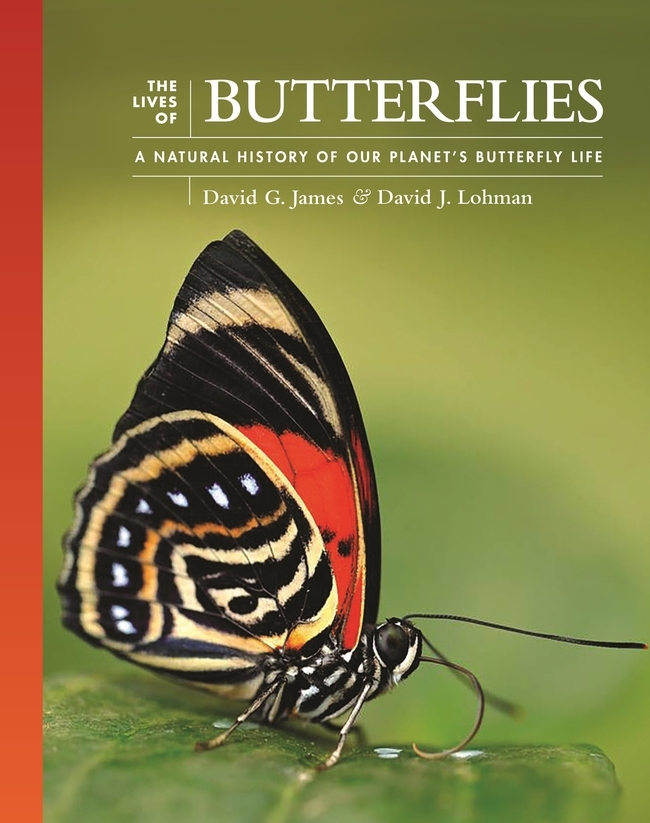
This 288-page book includes eight chapters: Introduction, Life Histories, Habitats and Resources, Butterfly Populations, Butterfly Seasonality, Defense and Natural Enemies, and Threats and Conservation. The close-up images, many by James, spring to life and really confirm their description of butterflies as the "colorful ambassadors of the world."
This is an easy-to-read, fascinating book, complete with a glossary, a list of butterfly families and resources, and, of course, an index.
Some tidbits. Did you know that:
- To date, scientists have described some 19,500 species of butterflies throughout the world?
- Scales give butterflies their color? “The colors of each butterfly have evolved to promote protection to the species from predators and to enable the sexes to find and recognize each other,” they write.
- Butterflies are classified into seven families based on their evolutionary history? And that each family shares physical, behavioral, and ecological features, including body structure, wing characteristics (venation, patterning, and color), host plants, and flight?
- The survival rate of eggs, caterpillars, pupae (chrysalids) is less than 10 percent? What you see are the survivors who have “escaped predation, parasitism, disease and death from unfavorable environmental conditions, including excessive heat, drought, cold, storms, and food shortages,” they relate.
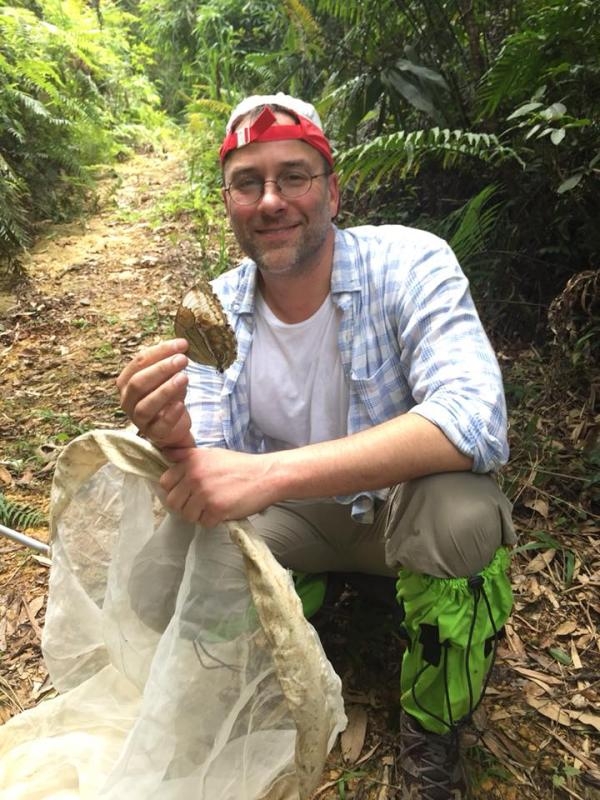
Butterflies, it seems, are also the equivalent of the proverbial “canary in the coal mine,” an early warning of danger in the ecosystem. Take the issue of the declining population of monarchs. Quoting statistics from the Xerces Society for Invertebrate Conservation, James and Lohman point out that monarchs have declined by 80 to 90 percent during the past two decades. The decline, they write, "is caused by a combination of habitat loss, pesticide use, and a warming climate.”
If you live in California, you're not allowed to collect or rear monarchs without a scientific permit.
According to the California Department of Fish and Wildlife: "A Scientific Collecting Permit (SCP) is required to handle wild monarchs in California including for educational purposes. It is unlawful to collect, remove from the wild and/or captively rear monarchs in California without an SCP, per California Code of Regulations (CCR), Title 14, section 650.
But the metamorphosis of a butterfly--from egg to caterpillar to chrysalis to adult--is nothing short of magical. As the authors so succinctly point out: "...our children are the future and it is they who will determine the future of butterflies. If a child finds a caterpillar, let them keep it, feed it, and watch it metamorphose.They will remember the experience for the rest of their life, and it will instill in them a love and appreciation for lives smaller than their own."
They add: “It is important that we do not try to excessively regulate to conserve butterfly populations. We need people to be part of the process and be the power on the ground behind conservation programs.”
The book could have easily been called "The Joy of Butterflies." Butterflies fluttering around the garden on a sunburst day, sipping nectar, and then laying eggs on their host plant, bring us great joy. We marvel at the magic, the miracle of it all.
This book is a great introduction to the lives of butterflies. You'll learn more about their life histories, their habitats, their seasonality, their defensive mechanisms, and what we can do to conserve "the colorful ambassadors of the insect world."
About the authors. James also co-authored Life Histories of Cascadia Butterflies and served as a consultant editor on The Book of Caterpillars. He completed his doctorate on the winter biology of Monarch butterflies and has published more than 200 scientific papers "on a wide range of entomological subjects," the publisher notes. Lohman, in addition to being a professor and department chair, the City College of New York, is a visiting scientist at the American Museum of Natural History, and a research associate at the Museum of Comparative Zoology at Harvard University and at the National Museum of Natural History in Manila. His research focuses on butterflies in Southeast Asia and the ecology, evolution, and conservation of biodiversity.
Their passion for butterflies, coupled with their exemplary research, shows.
Wings up!
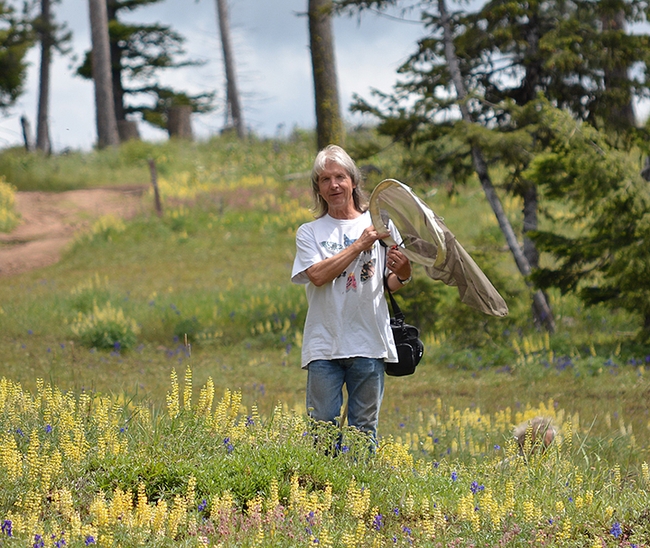
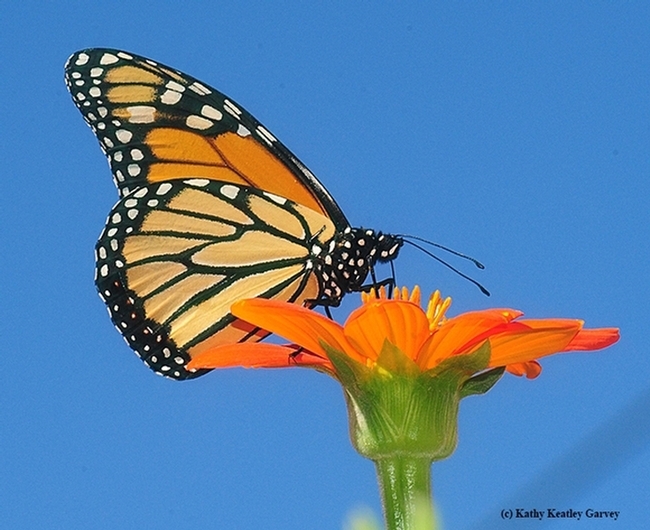
- Author: Kathy Keatley Garvey
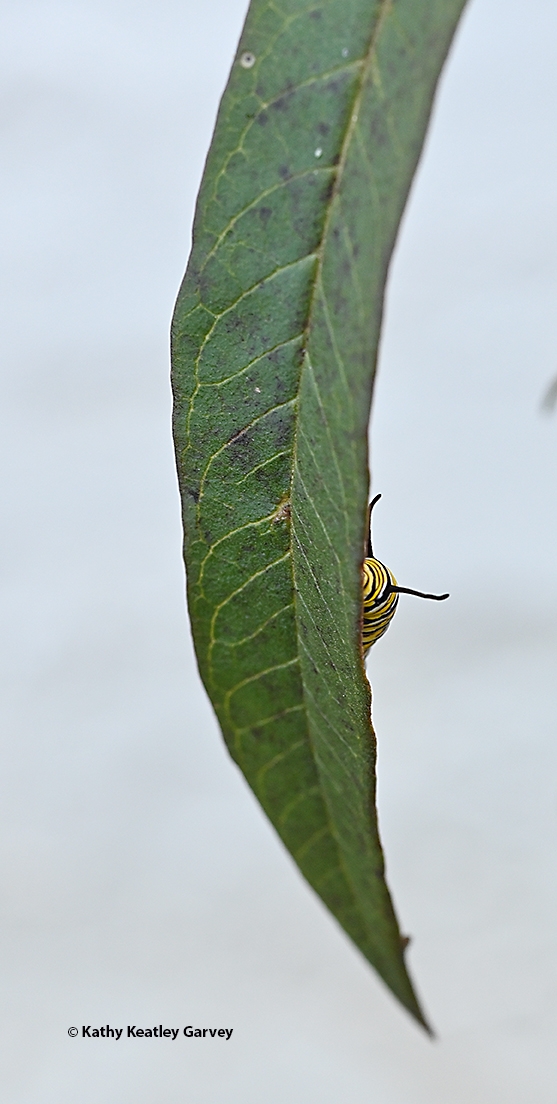
It lived--and quite hidden at that--through the freezing cold, the rain, and the wind. It surfaced today on a milkweed in our Vacaville pollinator garden.
Surprise, surprise! We neither saw it as an egg nor as a tiny caterpillar.
"Most larval mortality in monarchs occurs in the first 2 or 3 instars.. so they keep as hidden and low-key as possible," entomologist David James, an associate professor at Washington State University, told us. "Once they make it to the fourth instar, they are emboldened and are more likely to be seen exposed."
James, who studies migratory monarchs, earlier commented on the fall breeding: "The egg laying females you are seeing now are likely migrants that have eschewed reproductive dormancy for reproduction. This has probably always happened to some extent but is likely more significant now because of warmer falls. The lack of activity in summer in Vacaville was probably a function of most of the population having dispersed further east and north, maybe more than usual? They surely did pass through Vacaville in spring on their way north but clearly didnt stop to use your milkweeds. It does seem that some years they are more prone to frequent stopping/oviposition on their way north and east, yet in others they just keep flying. There's evidence that the latter was the case this year... with as many migrants making it to BC as to Washington...Normally they stop in Washington and only a handful make it to BC."
James is the author of a newly published book, The Lives of Butterflies: A Natural History of Our Planet's Butterfly Life (Princeton University) with colleague David Lohman of the City College of New York. The book, released in the UK on Oct. 3, 2023, will be available in the United States starting Jan. 9, 2024.
Irish scientist Éanna Ní Lamhna recently interviewed the WSU entomologist in a podcast on RTÉ, or Raidió Teilifís Éireann. The book, Lamhna said, "showcases extraordinary diversity of world's butterflies, while exploring their life histories, behavior, conservation and other aspects of these most fascinating and beguiling insects." (See Bug Squad blog). Listen to the butterfly podcast here:
https://www.rte.ie/radio/radio1/clips/22294525/
Meanwhile, we checked another milkweed plant in the garden today and spotted another caterpillar, this one a little smaller and less active than the first.
As UC Davis distinguished professor Lynn Kimsey, director of the Bohart Museum of Entomology, commented: "So much for diapause!"
Now our milkweed garden includes scores of hungry aphids, several species of milkweed, two 'cats, and maybe three (one 'cat went missing and is probably j'ing somewhere) and four chrysalids.
Will we have a Merry Chrysalis?
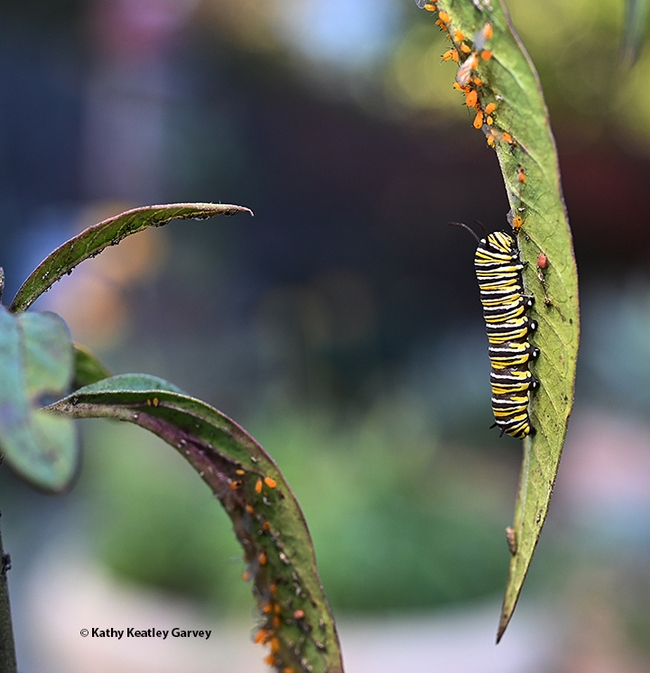
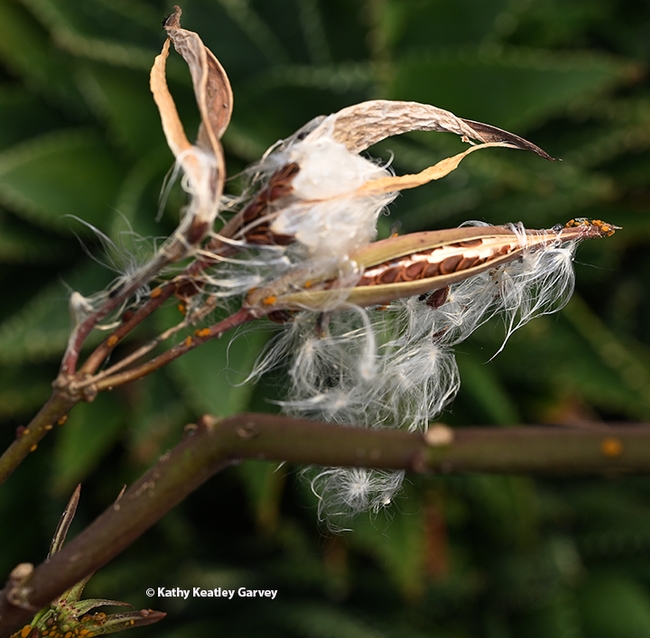
- Author: Kathy Keatley Garvey
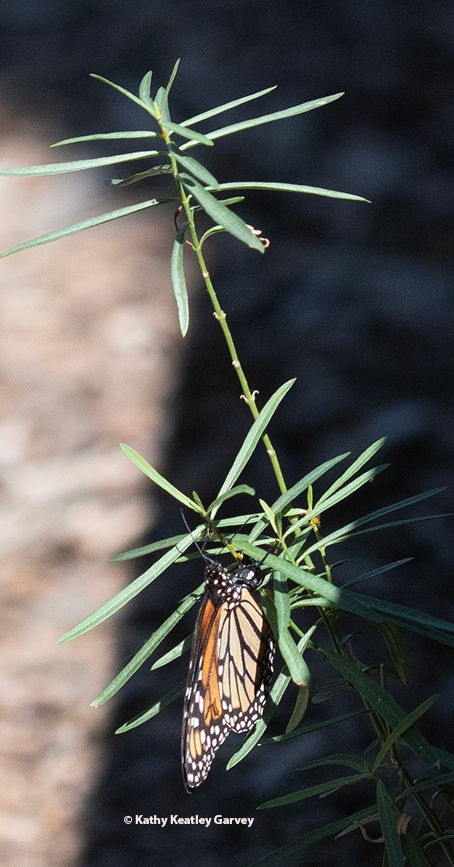
Where do Western monarchs go after leaving their overwintering sites along coastal California in February?
An observation: They didn't stop in the spring or summer to deposit eggs on any of our four species of milkweed in our Vacaville pollinator garden.
Spring? Zero. Zilch. Nada.
Summer? Zero. Zilch. Nada.
Fall? Yes.
Why not spring and summer? Did the monarchs passing through Vacaville opt for "a better habitat" in the cooler Pacific Northwest and beyond (British Columbia)?
"I wish I knew," commented UC Davis distinguished professor emeritus Art Shapiro, who has monitored the butterfly populations of Central California since 1972 and maintains a research website, Art's Butterfly World.
Beginning in September, as many five monarchs a day began fluttering into our garden. Some laid eggs.
To date, we've spotted some 20 eggs and caterpillars.
"This is generally consistent with the pattern we've seen in previous years," said UC Davis Department of Entomology and Nematology professor Louie Yang, who researches monarchs. "Even in Davis, we've been seeing more caterpillars in the late summer/fall. I think this is probably because some are stopping to lay eggs on the return migration, and the fall population is much larger than the spring migration population. Looking very carefully, we did also see eggs in the spring each year, but very few of them developed into large caterpillars." See the Louie Yang et al, research paper, "Different Factors Limit Early- and Late-Season Windows of Opportunity for Monarch Development," published in July 2022 in the journal, Evolution and Ecology.
The availability of food resources, such as tropical milkweed (Asclepias curassavica) that can overwinter in warmer climates, doesn't deter them from migrating, said UC Davis emeritus professor Hugh Dingle of the Department of Entomology and Nematology. Dingle, an internationally known expert on animal migration who has studied monarchs for more than two decades, said: "Migration and the diapause that accompanies it in the fall are determined by shortening photoperiod and temperature (warm temps can override short days hence the issue with climate change)."
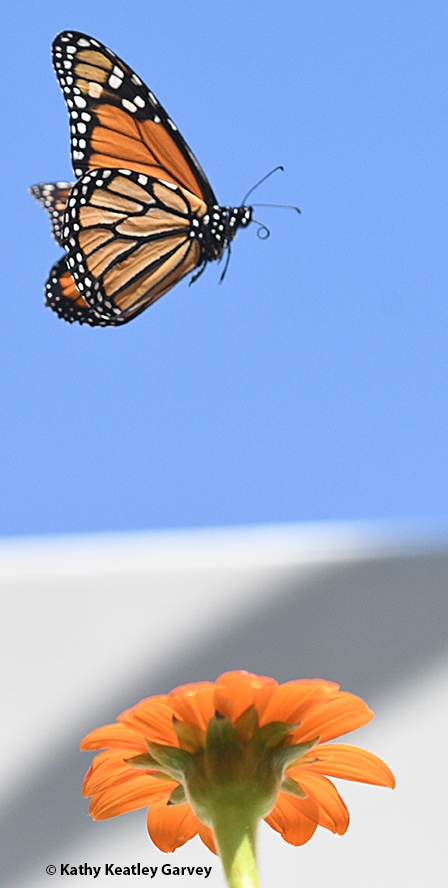
Said UC Davis professor Elizabeth Crone of the Department of Evolution and Ecology: "Monarchs may behave similarly in spring, but the spring population is probably much smaller than the fall one, so they are less likely to happen across your garden. Our estimate is that the population increases 2-3x each generation (so it's about 100-200x larger in Fall than Spring), then resets each year due to mortality during Fall migration and overwintering. There is some research from Sonia Altizer's lab in Georgia showing that monarch butterflies that encounter milkweeds during fall migration will leave reproductive diapause and breed. It is unknown whether these monarchs are effectively lost from the migratory population, or whether they or their offspring (the caterpillars in your yard) will continue on to the overwintering sites."
"The egg-laying females you are seeing now are likely migrants that have eschewed reproductive dormancy for reproduction," says entomologist David James, an associate professor at Washington State University who researches migratory monarchs. "This has probably always happened to some extent but is likely more significant now because of warmer falls."
"The lack of activity in summer in Vacaville was probably a function of most of the population having dispersed further east and north, maybe more than usual? They surely did pass through Vacaville in spring on their way north but clearly didn't stop to use your milkweeds. It does seem that some years they are more prone to frequent stopping/oviposition on their way north and east, yet in others they just keep flying. There's evidence that the latter was the case this year... with as many migrants making it to BC as to Washington... Normally they stop in Washington and only a handful make it to BC."
"The many mysteries of monarchs," James added.
James is the author of a newly published book, The Lives of Butterflies: A Natural History of Our Planet's Butterfly Life (Princeton University) with colleague David Lohman of the City College of New York. The book, released in the UK on Oct. 3, 2023, will be available in the United States starting Jan. 9, 2024.
Irish scientist Éanna Ní Lamhna recently interviewed the WSU entomologist in a podcast on RTÉ, or Raidió Teilifís Éireann. The book, she said, "showcases extraordinary diversity of world's butterflies, while exploring their life histories, behavior, conservation and other aspects of these most fascinating and beguiling insects." (See Bug Squad blog)
Listen to the butterfly podcast here: https://www.rte.ie/radio/radio1/clips/22294525/
Meanwhile, are you seeing fall breeding and egg-laying in your garden? We have for more than a decade, with some monarchs eclosing in November and December.

